Table of contents
- The best-selling motorcycles of 2008 Five top sellers and their owners
- Success has a name? BMW R 1100/1150/1200
- Honda CBF 600 ?? Girls motorcycle for real men
- The cult motorcycle par excellence? Suzuki Bandit 1200/1250
- RR ?? The spice is in the abbreviation: Honda Fireblade
- House slippers in sneaker design ?? Yamaha FZ6 Fazer S2
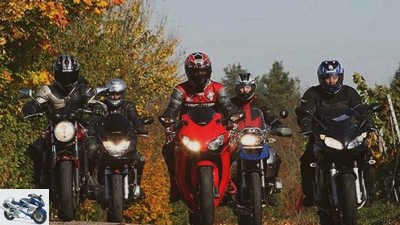
Jahn
motorcycles
The best-selling motorcycles of 2008
The best-selling motorcycles of 2008
Five top sellers and their owners
Regardless of the market share or sales figures, it is ultimately up to the gut to decide which motorcycle is in the shed. When, of course, function and fascination go hand in hand? even more beautiful. MOTORRAD and the proud owners tell the success story of the best-selling machines in 2008.
Werner Koch, Fred Siemer
05/01/2009
Success has a name? BMW R 1100/1150/1200
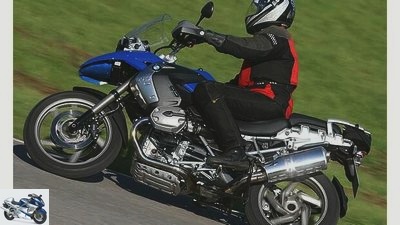
Jahn
The BMW R 1100 GS took first place on the 2008 top seller list.
When it first appeared in 1994, the R 1100 GS was a shock, and anyone who has ever placed it next to its rather shy predecessor knows why. Here an almost low-profile, technically rustic and fully functional vehicle, while the 1100 successor, on the other hand, is a gigantic techno bike with unconventional chassis technology and an imperial look. And above all: with a beak that would have been embarrassing to any curlew. Was this modernist monster to inherit from the beloved old GS? Should you compete with Honda’s Africa Twin on the slopes of this world and master everyday life and country roads at home? How would the octopus-like monster work in the field? Could the strange Telelever handle rough gravel or even jumps? Was the rear frame bolted to the engine suitable for carrying two people plus luggage? Some of these questions were wrongly asked, as we know today. The market for motorized mules is limited. The BMW bestseller answered all other questions by hurrying along: no other travel enduro has been more stable, sportier, safer on asphalt.
Gravel didn’t shock the new GS either, and the pillars raved about the comfortable seat cushions and the wonderfully large suitcases. Between 1994 and 1999, BMW sold an impressive 44,000 units of the very first series. Few of them were in Africa, but many of them puzzled the riders of normal street motorcycles on European soil. Aside from the racetracks, these giant enduros drove them everywhere where riding a motorcycle is really fun, just like that. And that all day long. From then on the egg-laying woolly milk motorcycle was only called GS, and BMW did an excellent job of consolidating this reputation. Not only through a comprehensive range of accessories, but also through development steps that were more or less read off the wishes of the customers: The 1150 GS, it appeared in the summer of 1999, had 85 instead of 80 hp, an even wider torque plateau and six gears – the last Designed to reduce speed as overdrive.
This symbiotic search for perfection reached its preliminary peak in 2004. Then the GS became easier, and correctly. At 242 kilos, so light that all other manufacturers literally froze in awe and lack of imagination. Triumph went to the Supermoto corner with the Tiger, Honda’s Varadero has been bobbing for years almost unchanged, and the Suzuki V-Strom 1000 became obsolete. KTM spoke up with the rugged all-terrain Adventure 990 in order to poach in the GS area, but this only marginally impressed the comfort-indulgent GS fan community.
Honda CBF 600 ?? Girls motorcycle for real men
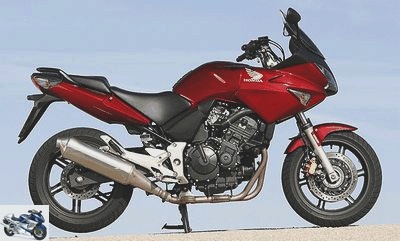
Second place goes to the Honda CBF 600.
For the optically shy appearance of the Honda, the motorcycle specialists and hardcore bikers should simply leave the comments in the style of boring, conservative and stuffy. If you cycle your home route to your heart’s content and with a good feeling in your stomach or are overwhelmed by the alpine panorama with sack and baggage at the top of the pass, you are also king with a simple CBF 600. Even at the first top test in MOTORRAD 7/2004, editorial colleague Thomas Schmieder got right to the point. “The dream, the fascination is motorcycling itself. One possible way to get there is the CBF 600.” Once you have understood this character trait of the CBF, regardless of whether it is the bare or the half-disguised S version, you can see the real qualities of Dedicate to Honda. And they start standing up because the currently cheapest motorcycle in the Honda range is equipped with a three-way seat height adjustment. I beg your pardon? The real biker doesn’t need something like that because only girls and cardboard noses fall over at the traffic lights? And how many indicators and mirrors have crumbled on the asphalt of the “real biker”? Ahh so, when in doubt it was always the girlfriend or the bumbling buddy. Already clear.
For such specialists, ABS is of course superfluous ballast. For everyone else who can rely on the Honda braking aid, especially in rain and bitumen, no moped will come into the house without ABS. Even if the four-cylinder’s 78 hp doesn’t tear up trees, the Honda is fast enough to knock down any automobile in the blink of an eye when it comes to a traffic light sprint or overtaking. Just as a small clue for the horsepower fetishists: In order to keep up with the CBF 600 in the sprint from zero to 100 km / h, a Mercedes SL 65 with 612 hp twin-turbo engine is required, which only accelerates from 140 km / h the Honda can drop off.
To ask? However, since such excesses exclude each other for 99 percent of CBF connoisseurs, the “gray mouse” spoils its rider with completely different qualities. Driving behavior that can hardly be surpassed in terms of neutrality and active safety, for example. After extensive driving tests in the border area, the author himself found a grammatically more than questionable, but maximally appropriate term for the CBF: unstoppable. Sure, you can criticize the overdamped and sometimes bumpy shock absorber, get excited about the somewhat phlegmatic engine draft or the clumsy tubular steel frame. But even that will not slow the Honda’s long-term success.
The cult motorcycle par excellence? Suzuki Bandit 1200/1250
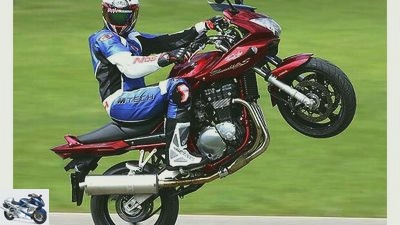
Bilski
The Suzuki Bandit 1250 / S is parked in third place.
In the beginning it was the ribs with which the simple Bandit 1200 revealed a piece of engine culture to the world in 1995. Until then, hidden in the plastic dress of the corpulent GSX-R 1100, the air / oil-cooled Suzuki engine with the delicate cooling fins should ensure a lot of joy and sometimes a good amount of extra income. First and foremost the street fighter scene, where they sawed and tinkered with everything. And because there is hardly a more beautiful inline four-cylinder, some implanted the gray fine rib monument in classic Kawasaki Z 900 or English special chassis. Even in the open racing class for naked bikes, the GSF 1200 raced right at the front. People with two left hands also enjoyed the big bandit, because the sophisticated concept relied on tried and tested components from the Suzuki range and was ennobled with the title indestructible, apart from a few quirks. In 1997, Suzuki gave the Bandit an anti-lock braking system – and was obviously a few years too early. In 2001, due to a lack of demand, the optional ABS was withdrawn from the range.
The 1200s, on the other hand, demonstrated their everyday qualities when they first met the Kawasaki Zephyr 1100 and Yamaha XJR 1200 in MOTORCYCLE 5/1996. Thanks to the sophisticated engine and foolproof driving behavior, the GSF 1200 ironed out the competition. At that time, more pressure and driving dynamics were not available for 14,220 marks. When the smart dealers gave the four-cylinder, which was stuffed to 98 hp, the air to breathe freely for little money, the friends of the really big torque found their peace. Even with the water-cooled 2008 model, pressure and torque are the pound with which the Bandit is rampant. In terms of handling and cornering, there are now a few new additions to the group of large-capacity naked bikes in front of the Bandit 1250, which now weighs 254 kilograms (1996: 236 kilograms). Which does not seem to detract from the popularity of the cult machine. And it could stay that way in the next sales year. After all, the 1250 Bandit proves to be extremely reliable in the 50,000-kilometer endurance test. The engine will be dismantled shortly, and the final balance sheet will appear in MOTORRAD in January.
RR ?? The spice is in the abbreviation: Honda Fireblade
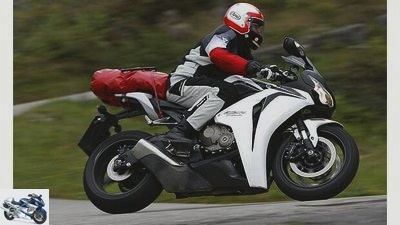
Artist
Fourth place goes to the Honda Fireblade.
The year 1992 was to usher in a new era for fans and freaks from the athletic ranks. An era in which Honda redefined the Superbike theme with the Fireblade. Away from the overweight muscleman, towards the light, nimble and lightning-fast super sports motorcycle with sophisticated racing technology. The 206 kilograms, openly fired by 128 hp, provided breathtaking dynamism and a hitherto unknown curve spectacle on winding racetracks. Sure, the competitors at the time were only allowed to pit on massively reinforced assembly stands to change tires. The GSX-R 1110 weighed 260 kilograms through the landscape, over 240 were the FZR 1000 from Yamaha, and even the 600 squad weighed significantly more than the CBR 900 RR.
Even if designer Tadeo Baba was either ahead of his time in some details (16-inch front wheel, standard in the MotoGP class today) or behind (missing steering damper), the competition stared in disbelief at a radical racer that the assembled stoker group was watching Knee pads paid homage. In this sense, Honda pursued the Fireblade concept for many years and several model changes to this day. Even if Tadeo Baba no longer acted as chief designer, the SC 57 models, which were completely redesigned for 2004, had preserved a few basic characteristics of the Fireblade philosophy. Drivability instead of brute power, quality instead of hastily penned technology.
This sometimes led to the fact that the real horsepower values lagged significantly behind the prospectus performance and many angry horsepower fetishists sued for the change. However, that does not change the fact that the current fire sword, abbreviation SC 59, is also very popular with buyers and distanced the entire ranks of athletes in the large comparison test in MOTORRAD 6/2008. If you exclude the harsh load changes and slight load jams between 3000 and 4000 rpm, the current Honda CBR 1000 RR can do everything a bit better and more precisely than the competition, and with the brilliant chassis, fine slip clutch and electronic steering damper is completely ready to race. On this riding iron you have nothing else in mind than to race away in a sprint – immediately and everywhere.
House slippers in sneaker design ?? Yamaha FZ6 Fazer S2

Artist
In fifth place: Yamaha FZ6 Fazer S2.
In 1998, Yamaha recognized a huge niche in the motorcycle market: the sport-comfort runabout. The answer to that was Fazer 600. A loud bravo with standing applause from all those who were tired of hunching on crouched running rolls, but are by no means snoring cones, but like to pull the throttle briskly. A clientele who really wanted to blow the march from the upright position without having the chiropractor pull them down from the motorcycle afterwards. The recipe for the sport-comfort speedster is not that easy, because the swift ride is only successful if a robust chassis can successfully defend itself against heavy lateral bending and other forces. So the Yamaha designers bent a sturdy but also heavy tubular steel frame around the defused sports engine of the YZF 600, decorated the whole thing with sporty attributes such as aluminum swingarm and blue-capped monoblock brake calipers, dipped the sparse plastic parts in an aggressive red color – and that’s it put the FZS 600 Fazer on the road to success.
Almost 20,000 buyers presented the comfortable speedster, uhhh sporty comfort speedster in the shed before Yamaha completely redesigned the Fazer in 2004. Now with an inexpensive cast aluminum frame that wraps around the motor of the YZF-R6 barrel organ with organic shapes and touches the senses with a chic silencer duo under the bench. The upright curve whistlers like it, and the new edition also duped the entire competition in the 2004 MOTORRAD comparison test. This does not mean that the FZ6 is suitable for every newcomer and returnee, because it only shows its capabilities when the rider is not afraid of revs and the switch foot does not stand still. What the Fazer fans can live with, because others are responsible for boredom and junk tours. The Fazer, without exception also the version FZ6 S2 with fairing, relies more on agile handling and a suitable active driving style. With the Yamaha concept, sport-comfort racing is turning into a real popular sport in Germany.
Related articles
-
In-line four-cylinder motorcycles in comparison
jkuenstle.de 17th pictures jkuenstle.de 1/17 BMW K 1300 R, Honda CB 1300, Kawasaki ZRX 1200 R, Suzuki Bandit 1250, Suzuki B-King and Yamaha XJR 1300 in…
-
MOTORCYCLE archive motorcycles The top ten motorcycles The top ten motorcycles The ten best sellers in 2005 These ten motorcycles are both an incentive…
-
125cc motorcycles put to the test
bilski-fotografie.de, Yvonne Hertler 32 pictures bilski-fotografie.de, Yvonne Hertler 1/32 Honda CB 125 R, KTM 125 Duke, Yamaha MT-125, Suzuki GSX-S 125…
-
Dream bikes from the editors – please build these motorcycles
Card design by Kar Lee 8th pictures Card design by Kar Lee 1/8 Suzuki GSX 1500 Bandit. That would be something: air-cooled four-cylinder with a decent…
-
48 hp motorcycles in used advice
viperagp – Fotolia / MOTORRAD 20th pictures Artist 1/20 A Harley Sportster 883 is only slightly above the A2 limit with an open 53 HP, a circumcision…
-
48 hp motorcycles 300 cc entry level comparison test 2018
Rossen Gargolov 23 pictures Rossen Gargolov 1/23 Right in the middle of the golden October. Rossen Gargolov 2/23 The test field consists of entry-level…
-
Motorcycles not coming in 2007
11 pictures Yamaha 1/11 Yamaha 2/11 Yamaha 3/11 Yamaha 4/11 Yamaha 5/11 Say 6/11 Yamaha 7/11 Yamaha 8/11 Yamaha 9/11 Yamaha 10/11 Yamaha 11/11…
-
New registrations July 2020: most popular motorcycles
KTM 20th pictures manufacturer 1/20 First place among new motorcycle registrations in July 2020: BMW R 1250 GS with 1,253 units. New registrations from…
-
Unusual motorcycles from Ducati, BMW, Suzuki and Yamaha
Jahn 23 pictures Jahn 1/23 Ducati Diavel: The devil’s roast from Bologna surprised the motorcycle world, its success even Ducati. Jahn 2/23 Ducati Diavel…
-
Nine 48 hp motorcycles tested for the A2 driver’s license
Jahn 44 pictures Jahn 1/44 Thanks Brussels: With the new tier driving license for young drivers and newcomers, the EU has given a hefty surcharge of 14…